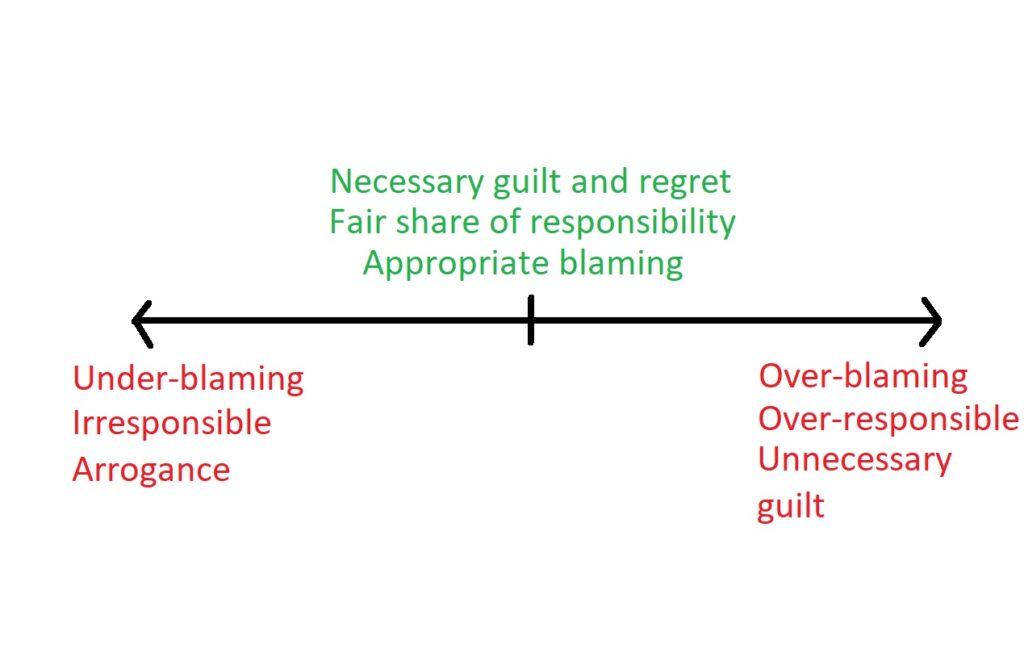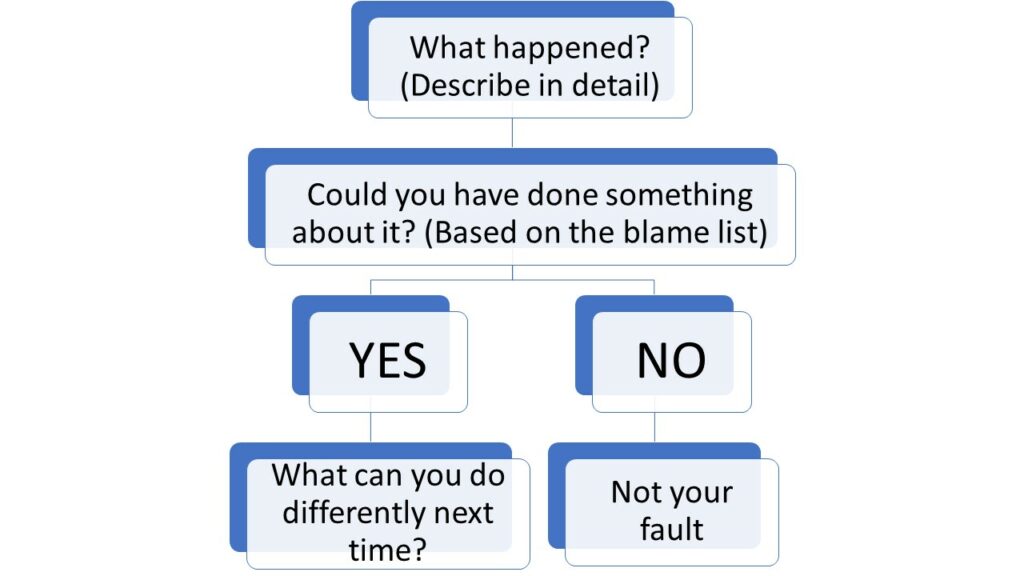When things go wrong in your life, do you find yourself thinking:
“Everything is my fault.”
“I always mess everything up.”
If you do, chances are you’re over-blaming yourself. Over-blaming or taking more than your fair share of responsibility for things can be just as bad as under-blaming.
Things go wrong every once in a while in life. Knowing when to blame yourself, when not to, and to what degree to blame yourself in a given situation is a master skill. If you haven’t worked on developing this skill, you risk bouncing between under-blaming and over-blaming yourself.
When you under-blame yourself, you’re not taking responsibility for things you ought to take responsibility for. Or you’re taking less than your fair share of responsibility. This is a sign of immaturity, arrogance, and egotism.
When you over-blame yourself, you take responsibility for things you have little control over or are outside your control.
Excessive and irrational self-blame leads to negative self-talk and feelings of guilt. You over-apologize and are likely to become a people-pleaser so you can make up for the ‘wrongs’ you did to them.

Behavioral vs. characterological self-blame
There are two types of self-blame, and both are observed in over-blaming yourself:
1. Behavioral self-blame
“Everything is my fault. I did very bad.”
The person blames their behavior for things going wrong. When you blame your behavior, you do that from a position of power. You believe that had you acted differently, things would be different.
This is a healthy way to think, but only when you’re appropriately blaming yourself. When you’re over-blaming yourself, this way of thinking isn’t helpful at all.
2. Characterological self-blame
It’s the deadlier version of self-blame that has been linked to depression.1Peterson, C., Schwartz, S. M., & Seligman, M. E. (1981). Self-blame and depressive symptoms. Journal of personality and social psychology, 41(2), 253.
It says:
“Everything is my fault. I am a bad person.”
The person blames their character for things going wrong. When you blame your personality, you do that from a position of powerlessness.
People generally perceive their character as more rigid than their behavior. It’s hard to change who you are. Which means you’ll keep messing things up. That’s just who you are and what you do.
Why you feel like everything is your fault
Regardless of the type of self-blame you engage in, the reasons you do it are several and interesting. If you can pinpoint what motivations are driving you to blame yourself unnecessarily, you can begin to change your faulty ways of thinking.
1. All-or-nothing thinking
Also called black-and-white thinking, it’s a pervasive cognitive bias. Reality is complex, with lots of grey in between the black and the white. But we’re prone to see things as either black or white.
If you look again at the above spectrum of responsibility, you’ll see that the opposite extremes of the spectrum are all (over-blaming) and nothing (under-blaming). Either everything is your fault, or nothing is.
All-or-nothing thinking is the default mode of thinking. It’s rare to see people who accept a 30% or 70% fault for things. It’s mostly either 0% or 100%.
2. Avoiding change
Self-blame, particularly characterological self-blame, can be a way to maintain the status quo. Maintaining the status quo is the most comfortable situation for humans to be in. Changing and growing takes energy and is uncomfortable.
If you believe that bad things happen to you because you’re a bad person, there’s nothing you can do about it. With over-responsibility, you avoid personal responsibility. You give up the power and necessity to improve yourself.
Fear of changing for the better is associated with low self-worth. You don’t feel worthy of becoming a better version of yourself because you don’t believe there can be a better version of yourself.
3. Actor-observer bias
This is another default way of thinking that causes many problems for people. The actor-observer bias is our tendency to only see things from our perspective while ignoring the perspectives of other people.
It leads to over-attributing agency to yourself and under-attributing it to external factors.
If something goes wrong in your life, you perceive it happening to you. You barely perceive it happening to others. Their contribution to the situation is vague, while your contribution is clear as the sky.
You have more information about what you did wrong than what they did wrong. So, blaming yourself comes naturally.
4. Anxiety
We feel anxious when we’re unprepared for an upcoming, usually novel, situation.
Anxiety makes you hyper-self-aware. Your self-consciousness and actor-observer bias gets magnified. It creates a cycle of self-blame and more anxiety.
Say you have to give a public speech. You’re worried you won’t do well.
You’re likely to blame yourself if something goes wrong during the speech because you were already anxious. You were expecting to make a mistake. You feel more anxious next time because you know you tend to mess things up.
All this, even if what went wrong was hardly your fault. Maybe the audience was tired after a long day of listening to speeches, and you thought you were boring them. Maybe the subject matter given to you to speak on was uninteresting. You get the idea.
5. Depression
Most self-blame in depression is justified. You feel depressed when you fail to accomplish an important goal repeatedly.
However, depression can also trap you in unjustified self-blame. Thinking about a genuine problem over and over can force you to see issues where there are none. This is connected to all-or-nothing thinking.
In life, you mostly move to and fro between two mental states:
“Everything in my life is good.”
“Everything in my life is bad.”
Even if there’s just one thing in one life area that is bad. Like happiness, depression related to one life area can spill over into other life areas.
6. Childhood trauma
Your excessive self-blaming may have been shaped during your formative years. It’s well-known that going through abuse can make the victims of abuse blame themselves.
“It happened to me; therefore, it must be me.”
Children are especially prone to such ways of thinking because their minds can’t yet comprehend the complexity of reality. Everything is about them, including abuse.
Childhood abuse can create a sense of shame that lingers for years into adulthood. If the child gets blamed for everything that goes wrong and has anything remotely to do with the child, self-blame becomes habitual.
For instance, a parent, trapped by their own bias, will likely blame their child for spilling a cup of milk than admit they bought a slippery cup.
7. Quick resolution
Humans tend to quickly resolve complex life situations- to explain the unexplainable promptly.
Blaming yourself as soon as something terrible happens can be a way to avoid further analysis of the situation.
Why would a person want to avoid further analysis of a situation?
Maybe they don’t realize how complicated reality can be. They just can’t grasp it. They’ve been fed easy answers all their lives, and they’re content with them.
Or maybe they don’t want something dark about themselves to surface. Better to blame yourself quickly and get out of the pickle than give others a chance to peek into your closet.
8. Gaining attention and sympathy
Some people can do anything to gain attention and sympathy. What happens after a person excessively blames themselves?
Sympathies pour in. The excessive self-blamer feels special and cared for. It’s fishing for sympathy.
9. Gaining trust
When people apologize for their mistakes, they win our trust and empathy. This effect is also observed in case of unnecessary apologies.2Brooks, A. W., Dai, H., & Schweitzer, M. E. (2014). I’m sorry about the rain! Superfluous apologies demonstrate empathic concern and increase trust. Social Psychological and Personality Science, 5(4), 467-474.
If people apologize for their mistakes, we feel good about them. We’re blown away if they apologize for something that isn’t even their fault. It shows they care a lot about us.
Hence the expression:
“I’m sorry for your loss.”
I’ve always wondered why we say it. After all, it wasn’t me who caused your loss, so why should I apologize?
It’s a non-apology. It’s just a way to show empathy and care.
10. The illusion of control
This applies more to behavioral than characterological self-blame.
When people overestimate their control over situations, they’re likely to engage in self-blame.3Davis, C. G., Lehman, D. R., Silver, R. C., Wortman, C. B., & Ellard, J. H. (1996). Self-blame following a traumatic event: The role of perceived avoidability. Personality and Social Psychology Bulletin, 22(6), 557-567.
“I could have avoided it.”
Could you really have avoided it?
Or are you just giving yourself a false sense of control because you’re not willing to accept that some aspects of reality are outside your control?
11. Denying vulnerability
This one is also linked to wanting to be in control.
Some people don’t like to think that external factors can harm them. They want to believe they have complete control over their lives.
So, when someone does harm them, they twist around the situation to make it seem like it was their own fault. They weren’t hurt. They’re too clever to get hurt. Others don’t have the power to harm them. Only they can harm themselves.
12. Decreasing social friction
Humans are social species. To us, maintaining social cohesion can sometimes precede accurately perceiving reality.
It could be that our ‘all-or-nothing’ thinking bias stems from our need to maintain good relations with our kin.
It seems that we have a built-in program that says:
“If something goes wrong, try not to blame your relatives.”
If we blame our close genetic relatives for every little thing that goes wrong, we risk spoiling our relations with them.
Of course, this effect diminishes as genetic relatedness decreases because maintaining good relations with distant relatives or non-relatives doesn’t impact survival and reproduction too much.
Getting out of the mess of thinking you mess up everything
It starts with using self-awareness to overcome default ways of thinking.
Whenever something goes wrong, try not to blame yourself automatically. It’s not fair. Instead, analyze the situation thoroughly and think about who or what else contributed to it and how much.
An exercise called responsibility pie can help you do this. When something goes wrong, you draw a pie and assign appropriate shares of responsibility to external factors contributing to the situation by drawing sections.
When you’re done, the remaining section is your responsibility.
I tried it but found the exercise hard to do. It’s hard to divide a circle into sections of responsibility.
What’s easier is making what I call ‘The blame list’.
When something goes wrong, and it’s not obvious what went wrong (perfect recipe for self-blame), list everything you think contributed to the situation. All the external factors first- the people and other environmental factors.
Imagine moving out of your body and looking at the whole situation from above.
When you’re done listing all the factors, assign a percentage of blame to each. When you’re done, the remaining portion is how much you should blame yourself.
For example, if you spill a cup of tea, instead of blaming yourself immediately for it, list down the contributing factors as under:
| Contributing factor | Blame percentage |
| Distraction from a neighbor using the drill | 50% |
| A family member poured too much milk into the cup | 10% |
| Slippery cup without a handle (bought by family) | 20% |
| The noise made by children | 5% |
| Boss stressed you out at work, so you were thinking about that | 5% |
| You heard shocking news and had to drop whatever you were holding (as in movies) | 0% |
| Your fault (You should’ve been more careful but you were too distracted by the music you chose to play) | 10% |
People go around in circles, blaming this and that when something terrible happens. It’s because they don’t usually factor in how much a thing or person is to blame. When you have the blame list, you can blame things more systematically and avoid going in circles.
Here’s another resource, a responsibility flowchart that can help you work through difficult situations and avoid excessive self-blame:

